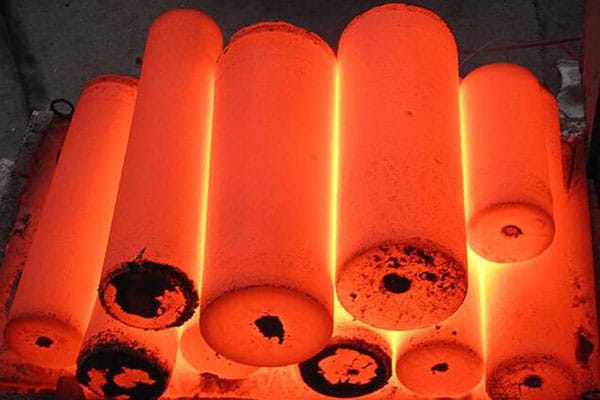410 stainless steel is a martensitic stainless steel that is commonly used in applications where high strength and moderate corrosion resistance are required. It is also known for its good hardness and wear resistance. Post-weld heat treatment (PWHT) is sometimes performed on 410 stainless steel to reduce residual stresses and improve the material’s mechanical properties after welding.
The purpose of post-weld heat treatment for 410 stainless steel is to temper the material and relieve any residual stresses that may have been introduced during the welding process. The specific heat treatment process and parameters can vary depending on the application and the desired properties.

410 Stainless steel chemical compositions
The typical chemical composition of 410 stainless steel are:
| Element | Percentage (%) |
|---|---|
| Carbon (C) | 0.08 – 0.15 |
| Silicon (Si) | 1.00 max |
| Manganese (Mn) | 1.00 max |
| Phosphorus (P) | 0.040 max |
| Sulfur (S) | 0.030 max |
| Chromium (Cr) | 11.50 – 13.50 |
| Nickel (Ni) | 0.75 max |
| Iron (Fe) | Balance |
410 Stainless steel annealing heat treatment
Annealing is a heat treatment process commonly used for 410 stainless steel to improve its machinability, ductility, and to reduce internal stresses. The annealing process involves heating the material to a specific temperature and holding it at that temperature for a certain period of time, followed by controlled cooling.
For 410 stainless steel, the recommended annealing temperature range is typically between 815°C (1500°F) and 900°C (1650°F). The exact temperature within this range may vary depending on the specific requirements and desired properties.
The annealing process typically consists of the following steps:
- Heating: The material is heated to the desired annealing temperature. It is important to ensure that the entire part reaches the target temperature to achieve uniform annealing.
- Soaking: Once the material reaches the annealing temperature, it is held at that temperature for a specific period of time. The soaking time depends on the thickness and size of the material. As a general guideline, a soaking time of about 1 hour per inch of thickness is often recommended.
- Cooling: After the soaking period, the material is cooled down slowly to room temperature. This can be done by turning off the heat source and allowing the material to cool in the furnace or by using a controlled cooling method such as furnace cooling or air cooling. The key is to avoid rapid cooling to prevent the formation of excessive internal stresses.
The annealing process helps to relieve internal stresses, refine the microstructure, and improve the machinability and formability of the steel.
410 Stainless steel Hardening heat treatment
To achieve hardening, the appropriate temperature range is between 925°C and 1010°C. Following the heating process, the steel is cooled using air or quenched in oil. Subsequently, tempering is performed to further enhance the hardness of the metal. This tempering process is carried out within the temperature range of 400°C to 580°C.
410 Stainless steel Tempering heat treatment
Tempering is a heat treatment process commonly performed on 410 stainless steel to improve its mechanical properties, specifically to enhance its hardness, toughness, and ductility. The tempering process involves heating the material to a specific temperature and holding it at that temperature for a certain period of time, followed by controlled cooling.
The recommended tempering temperature range for 410 stainless steel is typically between 400°C (750°F) and 580°C (1075°F). The exact temperature within this range depends on the desired properties and the specific application requirements. The higher the tempering temperature, the lower the hardness and the higher the toughness of the steel.
During tempering, the steel undergoes a transformation in its microstructure, known as the precipitation of fine carbide particles. This process helps relieve internal stresses and improves the material’s toughness and ductility while maintaining an acceptable level of hardness.
The duration of the tempering process depends on the steel’s thickness and the desired properties. Typically, a soaking time of around 1 hour per inch of thickness is recommended. After the desired soak time, the steel is slowly cooled, either by air cooling or by placing it in a furnace and allowing it to cool gradually.
410 Stainless steel stress relieving heat treatment
Stress relieving is a heat treatment process commonly performed on 410 stainless steel to reduce residual stresses that may have been introduced during fabrication, machining, or welding. The stress relieving process involves heating the material to a specific temperature and holding it at that temperature for a certain period of time, followed by controlled cooling.
For 410 stainless steel, the recommended stress relieving temperature is typically between 540°C (1000°F) and 620°C (1150°F).
The stress relieving process typically consists of the following steps:
- Heating: The material is heated to the stress relieving temperature. It is important to ensure that the entire part reaches the target temperature to achieve uniform stress relief.
- Soaking: Once the material reaches the stress relieving temperature, it is held at that temperature for a specific period of time. The soaking time depends on the thickness and size of the material. As a general guideline, a soaking time of about 1 hour per inch of thickness is often recommended.
- Cooling: After the soaking period, the material is cooled down slowly to room temperature. This can be done by turning off the heat source and allowing the material to cool in the furnace or by using a controlled cooling method such as furnace cooling or air cooling. The key is to avoid rapid cooling to minimize the reintroduction of stresses.
The stress relieving process helps to reduce residual stresses, improve dimensional stability, and minimize the risk of distortion or cracking during subsequent processing or service.
